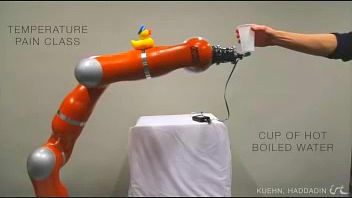Finally, a robot that responds by feeling "pain" will be developed

ByKeoni Cabral
"In one case, based on the premise that" ability to respond to bruise "is also effective for robot", let the robot learn how to feel pain "Artificial robot nervous system"Is being developed by the research team at Hannover University. If it is put into practical use, it will be possible to take avoidance action quickly against contacts that may cause the industrial robot to fail, and it will be possible to prevent damage to parts of the robot itself. A movie in which the painfully robotic arm actually reacts reflexively has also been released.
Researchers Teaching Robots to Feel and React to Pain - IEEE Spectrum
http://spectrum.ieee.org/automaton/robotics/robotics-software/researchers-teaching-robots-to-feel-and-react-to-pain
Because robots do not have pain sensation, they can work in a dangerous environment. This is regarded as an advantage of the robot, but Johannes Kuhn of the University of Hannover and colleagues etc. took an idea of becoming a painful sense system for "a robot working near a human being" in StockholmIEEE(American Institute of Electrical and Electronic Engineers) international conference.
According to Mr. Kuhn, it is expected that robots working near humans will increase in the future. By installing a system that reacts to damage to the robot, it is possible to prevent accidents due to damage of internal equipment that is difficult to detect. A system that robots avoid collisions with humans has existed from the past, but by installing pain sensation, it seems that the safety of both people working in the surroundings and the robot can be enhanced. Based on this claim, the research team at Hannover University devised a robot controller that imitates the human pain sensation system. A robot connected with this controller will be able to obtain "reflexes" for potential danger.
You can see how the robot controller 's "robot nervous system" reacts in the following movie.
Artificial Robot Nervous System to Teach Robots How to Feel Pain - YouTube
Attached to the tip of the orange robotic arm is a prototype of a controller that detects "pain". BioTac'sFinger type / biomimetic tactile sensorIt is equipped with not only tactile sense but also pressure and temperature can be felt. First of all, let's give the sensor "light pain" ...

The robotic arm responded to mild pain and made a movement to leave a little away from the human hand which is the source of pain. The robot feels mild pain as "uncomfortable" contact and considers it to be a contact that may be damaged or interfere with a defined task. The robot slowly evades until the contact is over and returns to its original position when the contact is over.

"Medium pain" followed by a strong contact.

When the robot feels moderate pain, it is set to take avoidance action quickly. It is like a human being who suddenly stuck a pin and felt pain, the distance to avoid is greater than mild pain, taking avoidance behavior away from danger until contact is over. It returns to the original position when the contact is over.

When some kind of contact is received, I take an evasive behavior and do a reflexive response to return to the original position, but if I get the next contact before returning to original ... ....


We are continuing to evade further contacts that we avoided.


In the end when you receive "severe pain". Painfulness is the possibility that the robot has been damaged and it is classified as level of contact that needs some help.

To prevent the deterioration from the damage received, the robot given a severe pain turns on the gravity correction switch instead of avoiding it.

This improves the "damping control" function that the robot passively controls against external forces. When a robotic arm that has suffered severe pain is moved by a human hand, it moves like a force to pass.

At the end, "Pain due to temperature", a cup containing boiling water was placed on the sensor.

After a while, the robot feels the heat and is taking evasive action, and it shows a reflexive reaction like a human being that it seems to be heard as "hot!" The top priority in robotics engineering is "robots do not hurt people", but as robots increase around humans in the future, it is important for robots to behave not to "injure" ... apparently ...

Related Posts:







